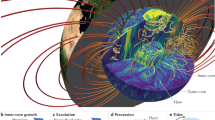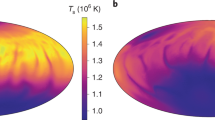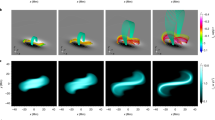Abstract
As carbonaceous chondrites are the least thermally-evolved and hence the most primitive of the meteorites, their residual magnetization can, in principle, be used to estimate the intensity of the magnetic field in the primordial solar nebular, which varies between 0.2 and 1 G (refs 1–4), and could be as high as 2–3 G (ref. 4). The presence of palaeomagnetic fields of such magnitude is of importance in reconstructing the early history of the Solar System and of planetary formation. Levy and Sonnet5, for example, have stressed this point in comparing the respective merits of four alternative sources of the primordial magnetic field. They claim only two of these are possible: (1) a large solar magnetic field spread into the solar nebula; (2) a hydromagnetic dynamo field generated in the solar nebula itself. We show here that there is in fact a further possibility that fits the requirements for strong magnetic field generation and energetic particle irradiation of the grains6: magnetic field enhancement at the point of stagnation between the solar nebula and the intense solar outflows. This mechanism, which involves the interaction of the T-Tauri wind with the solar nebular, is straightforward and is supported by results from recent space research.
This is a preview of subscription content, access via your institution
Access options
Subscribe to this journal
Receive 51 print issues and online access
$199.00 per year
only $3.90 per issue
Buy this article
- Purchase on Springer Link
- Instant access to full article PDF
Prices may be subject to local taxes which are calculated during checkout
Similar content being viewed by others
References
Butler, R. F. Earth planet. Sci. Lett. 17, 120–128 (1972).
Banerjee, S. K. & Hargreaves, R. B. Earth planet. Sci. Lett. 10, 392–396 (1971).
Brecher, A. in Origin of the Solar System (ed. Reeves, H.) 260–272 (CNRS, Paris, 1972).
Lanoix, M., Strangway, D. W. & Pearce, G. W. Proc. 8th lunar Sci. Conf., 689–701 (Pergamon, New York, 1977).
Levy, E. H. & Sonett, C. P. in Protostars and Planets (ed. Gehrals, T.) 516–532 (University of Arizona Press, 1978).
Lal, D. in Early Solar System Processes and the Present Solar System (ed. Lal, D.) 192–214 (North-Holland, New York, 1980).
Herbig, G. H. Adv. astr. Astrophys. 1, 47–103 (1962).
Horedt, G. P. Moon Planets 21, 63–121 (1979).
Canuto, V. M., Levine, J. S., Augustsson, T. R. & Imhoff, C. L. Nature 296, 816–820 (1982).
Wetherill, G. W. Icarus 46, 70–80 (1981).
Alfvén, H. Tellus 9, 92–96 (1957).
Russell, C. T., Luhmann, J. G., Elphic, R. C. & Neugebauer, M. in Comets (ed. Wilkening, L. L.) 561–587 (University of Arizona Press, 1982).
Ip, W.-H. & Mendis, D. A. Icarus 29, 147–151 (1976).
Schmidt, H. U. & Wegmann, R. in Comets (ed. Wilkening, L. L.) 538–560 (University of Arizona Press, 1982).
Fedder, J. A., Brecht, S. H. & Lyon, J. G. Icarus (in the press).
Galeev, A. A., Cravens, T. E. & Gombosi, T. I. Astrophys. J. (in the press).
Wallis, M. K. & Dryer, M. Astrophys. J. 205, 895–899 (1976).
Author information
Authors and Affiliations
Rights and permissions
About this article
Cite this article
Ip, WH. Magnetic field amplification in the solar nebula through interaction with the T-Tauri wind. Nature 312, 625–626 (1984). https://doi.org/10.1038/312625a0
Received:
Accepted:
Issue Date:
DOI: https://doi.org/10.1038/312625a0
This article is cited by
-
Noble gas components in planetary atmospheres and interiors in relation to solar wind and meteorites
Journal of Earth System Science (1998)
Comments
By submitting a comment you agree to abide by our Terms and Community Guidelines. If you find something abusive or that does not comply with our terms or guidelines please flag it as inappropriate.



